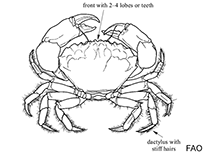Menippe nodifrons Stimpson, 1859
Lumpy stone crab| Native range | All suitable habitat | Point map | Year 2050 |

|
| This map was computer-generated and has not yet been reviewed. |
| Menippe nodifrons AquaMaps Data sources: GBIF OBIS |
Google image | No image available for this species;
drawing shows typical species in Menippidae.
Classification / Names Common names | Synonyms | CoL | ITIS | WoRMS
Malacostraca | Decapoda | Menippidae
Environment: milieu / climate zone / depth range / distribution range Ecology
Benthic; depth range 0 - 27 m (Ref. 101594). Tropical; 27°N - 29°S, 98°W - 14°E
Distribution Countries | FAO areas | Ecosystems | Occurrences | Introductions
Atlantic Ocean: Florida, Gulf of Mexico, Central America, Antilles, northern South America, and Brazil (from Maranhão to Santa Catarina), and from Cape Verde islands to Angola.
Length at first maturity / Size / Weight / Age
Maturity: Lm 3.8 range ? - ? cm Max length : 4.9 cm CL male/unsexed; (Ref. 435)
Life cycle and mating behavior Maturity | Reproduction | Spawning | Eggs | Fecundity | Larvae
Main reference
References | Coordinator | Collaborators
Fischer, W., G. Bianchi and W.B. Scott (eds.). 1981. (Ref. 435)
IUCN Red List Status
(Ref. 130435: Version 2024-2)
CITES status (Ref. 108899)
CMS (Ref. 116361)
Threat to humans
Human uses
| FishSource |
Tools
More information
Max. ages / sizes
Length-weight rel.
Length-length rel.
Length-frequencies
Mass conversion
Abundance
Internet sources
BHL | BOLD Systems | CISTI | DiscoverLife | FAO(Publication : search) | Fishipedia | GenBank (genome, nucleotide) | GloBI | Gomexsi | Google Books | Google Scholar | Google | PubMed | Tree of Life | Wikipedia (Go, Search) | Zoological Record



